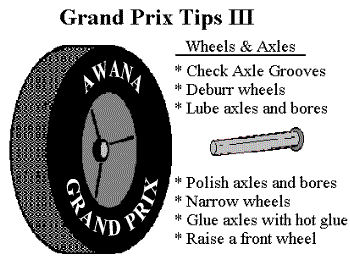| Grand Prix Racing - |
How To Make A Fast Pinewood Car |
Lubricate the Axles
Besides polishing the axles and wheel bores, lubrication is the most
important factor in the speed of your car. But just lubricating may not
enough. If you use a dry lubricant, you must apply it to your axles BEFORE
you attach them to your car! Many Grand Prix participants who might other
wise win, lose because of failing to do this one simple thing. Care must
also be taken not to apply too much lubricant. The best lubricant over
applied can be worse than none at all. Lubrication is essential but can be
tricky.
In general, oily or wet lubricants (even WD-40) are worse than none at
all, especially on axles that have not been polished. After a while, they
can soak into the oils in your wheel and become sticky. If you must, apply
them the day of the race.
Dry lubricants are powders. Powders include PTFE,
pure graphite and graphite with additives like molybdenum. Some have used
talcum powder. The problem with powders is keeping them on the axle. There
is a "dry" white lubricant (PTFE?) sold in some hobby stores for Grand Prix
cars. It claims it stays put better. It sure does, it sticks. It's worse
than using none. Apply these when you attach your axles and wheels to the
car. Further application will make little difference.
These are the best. They spray on wet and "dry" onto the surface forming
a thin coat around the axle and wheel bore. It comes with silicon and
teflon. Some are completely synthetic. The best part is that you can buy
them in the hardware section of your local department store. Avoid those
that claim to "penetrate" - it will soak into your wheels and gum things
up. Over a period of time, they become sticky, so apply them an hour or so
before the race so it has time to dry but not gum things up.
|
For the Winner
|
To relubricate for your wider area event, begin by melting the
glue around the axles with your glue gun. Strip any glue left on the
axles off. Re polish the axles and wash in denatured alcohol to
remove any debris. Soak a lint free paper towel in denatured alcohol
and twist it through each wheel hub to clean them. Follow the advice
above to lubricate as you remount and realign your axles and wheels
or to wait just before the event.
|
|---|
|
- Lubricate the axle BEFORE putting it on the car. Failing in this
point will mean a slow first race. Subsequent races will usually be
faster as the lubricant works in, but they will still be slower than they
could have been. Follow the instructions on the container. Be sure to
wipe off excess.
- Lubricate the wheel bore before putting the axle in the wheel.
- Lift your car up to work on it. This opens the wheel - axle
interface.
- Tear a piece of paper towel and insert it over the wheel around the
hub to keep the spray off the inside of the wheel.
- Spray the inside wheel bore area. The lube will spread over the bore
and to the back of the axle head.
- Now turn your car upside-down and spin your wheels a few times to get
an even coat. It dries in a few minutes.
- Rub a bit on the inner edges of the treads. It may help to reduce
friction with the lane median on some tracks.
While holding your car upside-down, give your newly lubricated wheels a
spin with your finger. Feel the vibrations? They should spin for more than
five seconds with very little vibration, or none at all.
|
Hot Tip
|
Use hot glue to glue in your axles! If an axle/wheel does not spin
freely for a few seconds, most lubricants can be removed by lightly
repolishing the axle or by cleaning with denatured alcohol. Remove
your axle by applying a hot glue gun to melt the glue. Remove any
glue stuck to the axle and clean it. Try applying less of the
lubricant until the test is satisfactory.
|
|---|
|
Avoid getting lubricant on the wheel tread. If you do, lubricant may
wipe onto the track. Your car might be disqualified! It is no speed
advantage either.
In order to reduce friction between the body and the wheel once the
wheels are attached, lubricate the area of the body on the sides of the
axle grooves where the wheel bore end will rub the body. This is especially
important if you cant your axles downward.
|
For the serious competitor
|
You can time your car in a 10 foot rain gutter with end caps or
other straight 10 foot ramp. Raise one end 6 inches and put supports
down the length of the gutter (ramp). Your car should be able to roll
down this ramp in 4.3 seconds. The faster the better.
|
|---|
|
PTFE (Polytetrafluoro-ethylene) is sold in Scouting stores. It is
another name for the plastic Teflon or Fluon. In general, plastics can be
made more "slippery" by mixing them with additives like graphite and
molybdenum disulfide. It is not certain whether a mixture can produce a
better lubricant.
| Grand Prix Racing - |
How To Make A Fast Pinewood Car |
| Copyright © 1997, 2000, 2001, 2002, 2004 by Michael Lastufka, All rights reserved worldwide. |
